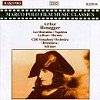
This important study covers both life and works of Arthur Honegger (1892-1955)
in considerable detail. Halbreich is to be congratulated for his meticulous
researches and analytical acumen. The book was originally published in French
in 1992.
Part One of the book, occupying just over 200 pages, covers Honegger's
life.
Halbreich has gone to considerable trouble checking (and quoting from) diaries,
letters, press notices, and a whole assortment of documents to chart all
the many journeys, all the concerts and all the events that shaped the composer's
life. In doing so he has corrected many inaccurate and misleading statements
made by previous biographers.
Honegger was born on 11th March 1892 at Le Havre where his father
imported coffee. (Le Havre, on the northern coast of France, was a prosperous
seaport in those days.) Honegger's parents were Swiss. He was a tough lad,
mad keen on sport, and fascinated by the sea. He was to live at Le Havre
until his coming of age save for two years spent studying in Zurich where
he found himself, for the first time, in a large city with a flourishing
musical life. When the coffee merchants of Le Havre were ruined after the
1914-18 war, his parents returned to Switzerland and Honegger went on to
Paris. As Halbreich says, "He was French and Parisian in culture, in intellectual
affinities, and soon, in his career; but profoundly Swiss in his roots, his
feeling for the past, and in his inner nature." He always kept his Swiss
passport but never tried to benefit from his duel nationality.
Halbreich then goes on to cover Honegger's student days in Paris where he
studied violin with Lucien Capet and counterpoint with André
Gédalge. He met Charles Münch (who would become his most faithful
interpreter), Ibert, Milhaud, Enesco, Taillefrerre, Auric, Poulenc, Satie
and Jean Cocteau. In 1916 he entered the conducting class of Vincent D'Indy.
Halbreich covers the formation of Les Six but also reminds us how
far Honegger's ideas were removed from those of the rest of Les Six.
"Honegger, despite being the Swiss Romantic, "the least Six of the Six,"
and their "honorary member", nonetheless subscribed to the group's aesthetic
in some of his works and would continue to do so occasionally for many years."
In 1917 Honegger met his future wife Andrée Vaurabourg ("Vaura").
Vaura was an excellent pianist and she soon became Honegger's favourite
interpreter. She had considerable gifts as a composer but sublimated these
to further Arthur's career. Nevertheless she became one of the best counterpoint
and harmony teachers of her time - she taught a young Pierre Boulez! Their
romance was troubled for Honegger also fell under the spell of the singer
Claire Croizer, nearly ten years older than himself. Paul Valéry called
her voice "the most sensitive of our times." Both women were, at first, close
friends, but after Vaura found Claire and Arthur under the same roof while
rehearsing Judith, the fur flew and Honegger found himself being fought
over by two women who both loved him passionately. Things came to a head
when Claire became pregnant but Honegger chose to marry Vaura on condition
that they live apart. (Honegger needed to be alone to compose.) They did
so until the last year of his life when he was too ill to manage on his own
(and in that year he produced not a single note of music.) Clearly both women
were hurt. Halbreich writes with sensitivity on this situation. "…we
are not talking here of those cheap "eternal triangle plots" …The three
people concerned were all exceptional human beings, and the two women, who
had once been so close to one another, would always retain a mutual respect
and esteem."
Part One goes on to cover Honegger's rise to fame through Pacific 231 (and
its prior influence, Honegger's score for Abel Gance's film La Roue
(1922) [see my review of Arthur Honegger's film scores on Marco Polo
8.223134], through the huge successes of Le Roi David and
Les Adventures du roi Pausole, through other major dramatic works like:
Judith, King Arthur, Horace victorieux, Antigone,
Cris du monde and Jeanne d'Arc au bücher, through the
film scores like Napoléon, Les Misérables and
Mayerling, and through the symphonies etc.
Cris du monde was composed in 1931 and after Antigone, the
work closest to Honegger's heart. Halbreich explains that it "is a bitter
testimony to a profound personal crisis and to a general crisis provoked
by the deep economic depression that followed the Wall Street crash of 1929"
and the resulting misery and unemployment experienced by millions.
Cris du monde was also a warning of other matters: the dangers
of totalitarianism, the decreasing quality of life, about the environment,
pollution, mass culture, pressure of noise, the media etc. Honegger was nothing
if not prescient.
Although the Great War never really touched Paris, the Second World War was
a different matter. Honegger could have claimed immunity and settled in
Switzerland for the duration; instead he chose loyalty to Paris and shared
in the depravations of the Occupation earning the undying affection of its
people. Always a trencherman, he more than made up by gorging himself when
better times returned so much so that his indulgence precipitated the 1947
heart attack (while he was on tour in America) that signalled the beginning
of his decline in health. Halbreich goes on to cover the fruits of Honegger's
last years like the terribly pessimistic Fifth Symphony, Concerto de
camera, and Monopartita. Halbreich's coverage of Honegger's sufferings
over the last years of his life is harrowing but deeply-moving.
Part Two is an Inventory of Works.
The first chapter covers Chamber Music and Art Songs categorised by type
(e.g. Music for Piano, Two Pianos, and Organ; and String Quartets). The second
chapter is devoted to Orchestral Music: Symphonies, Concertos; Other Orchestral
Works; and Orchestral Works from Stage and Film. A third chapter is entitled
Theatre and Musical Frescoes, covering Cantatas and Oratorios, Operas, and
Ballets. The fourth chapter is concerned with music for the stage, radio
and films. Then in the final chapter of this Part, popular songs, operettas
and various unclassified works are covered. Part Two occupies some 326 pages
and Halbreich covers Honegger's works in meticulous detail, offering insightful
analyses and fascinating background detail. I have quoted copiously from
this section of the book in my reviews of Honegger's works.
In Part Three Halbreich sketches in more detail about the composer so
that Honegger emerges as a very real character.
In the chapter "Honegger's Physique and Character" Halbreich takes us though
the changing portraits that were the composer's life: "adolescent "skinny
cat look", that "changes as the face became fuller and more pronounced, and
his expression becomes dreamy and gentle…"; …1925 with Les
Six, looking "rather cool, fixed frankness…" at the time of
Rugby "wearing his driving outfit - we see all the virile yet gentle
brilliance of his early maturity"…then in overalls on the footplate
of a stationary Pacific locomotive. During the war - "we see an
unmistakably democratic, even proletarian Honegger, with a beret and shopping
basket, pushing a bike." All these portraits contrast heavily with the decline.
His "sporty outline gradually spread with age to a certain portliness encouraged
by a healthy appetite…" Once, caught munching chocolate cake, Honegger
said, "Don't worry, with me it all gets turned into music!"
He had a real taste for conviviality and social life, and divided his time
between his friends and family. Of his character, Fritz Münch (Charles's
brother) said of him at his funeral: "We were all profoundly struck by the
humanity emanating from this man, by the goodness that formed the ground
of his being, and by the complete absence of ill-nature, jealousy or
pettiness…he was never negative and never wounded anyone unnecessarily
- he always brought a positive approach to everything he said and did, and
he always loved the young, and not only the young…" Milhaud spoke of
his relentless hard work and of his good nature and modesty. His popularity
for a composer of "serious music" was very high because of his light music
and his film music. Once, he was delighted to discover a picture of himself
included in a tin of a popular brand of French cocoa as a promotional gift!
The publication Point de vue carried a photograph of him with the
caption: "Arthur Honegger, an eclectic composer, has two audiences: the music
lovers of the Salle Pleyel, and the working girls who patronise cheap cinemas."
That is really popular fame.
Halbreich goes on to discuss the tug between Honegger's Swiss and French
backgrounds and in a revealing analytical table demonstrates that many
commissions and the majority of Honegger's premieres came from, and were
held in Switzerland. Halbreich goes on to discuss Honegger's social and political
ideas (covered briefly in my remarks about Cris du monde above)
and religious beliefs reminding us that "religious inspiration is certainly
the longest and strongest string in Honegger's creative bow." In another
chapter on Honegger's tastes and influences, we learn that Honegger was a
voracious reader, and an avid newspaper reader amassing clippings carefully
pasted into little notebooks and glossed with biting remarks. He was fond
of novels, particularly detective stories and was a keen Maigret fan. He
admired poetry, loved the cinema, adored trains and model trains. He counted
many poets amongst his friends and collaborators - Jean Cocteau, Paul
Valéry and René Morax - and, particularly, Paul Claudel. His
tastes in music are also covered: his love of Bach and Wagner and Fauré,
for instance, and his general lack of affinity for Schubert, Mozart, Schumann
and Chopin. We are reminded that Honegger was also an influential critic
whose music reviews showed great insight. Halbreich also reminds us of Honegger's
writings in Je suis compositeur in which he scorned, and predicted
the demise of the musical "ice-age" - the emptiness of the serial system
and the absurdity of judging music on how it looked on paper rather than
how it sounded when played. Another chapter takes us deeper into Honegger's
musical language and the book ends with Halbreich final assessment of Honegger
as belonging among the "greats" of the twentieth century. He concludes:-
"Sometimes, when you are at the foot of a mountain, you are overwhelmed by
its vastness. As you leave the mountain, via the narrow valley that descends
towards the plain, the great summit is hidden, because of the twists of the
gorge, by smaller peaks that suddenly seem to be higher than the great summit.
But as soon as you get down to the plain, the summit reappears and the farther
away you go, the higher up the horizon it climbs, until finally it takes
its rightful place among the family of great snow-capped peaks. That is how
I see Honegger's posthumous reputation."
The book includes 16 pages of illustrations, a chronological list of works,
a note on the reason why no discography was included (an unfortunate and
unnecessary omission in this reviewer's opinion), notes on the text of all
chapters, and separate indexes for names and works.
A big book that requires a big commitment from the reader nevertheless
unhesitatingly recommended.
Reviewer
Ian Lace

Harry Halbreich is a prominent scholar and writer on musical subjects.
He has previously written books on Olivier Messiaen and Claude Debussy. He
lives in Brussels.


